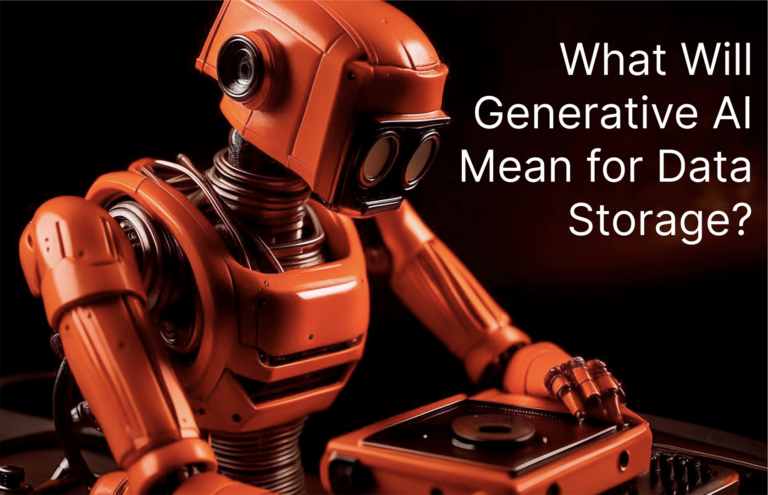This blog on generative AI was co-authored by Calvin Nieh and Carey Wodehouse.
There’s a pattern when it comes to enterprise adoption of innovations and trends: Pilot first, plan later. The “how” can be an afterthought (just ask IT after the last few years), but it’s often the most important. Success with a new technology ultimately depends on if your infrastructure can sustain it.
With generative AI, one thing is clear: Data infrastructures need to level up now.
GenAI Isn’t a Novelty—It’s Digital Transformation on Rails
It’s been said every company has to be a security company. Now, every company will have to be an AI-ready company, too.
Why? For the first time ever, AI’s barrier to entry has been toppled. It’s no longer the sandbox of data scientists; it’s for everyone. We’re just getting started.
Generative AI use cases are proliferating daily in the enterprise space. Companies like Databricks, which acquired MosaicML, will bring secure, generative AI models to enterprises, while Snowflake’s acquisition of Neeva will bring LLM-powered business intelligence to enterprise data. All of this signals the magnitude of its disruption for every industry. And in recessionary times, the efficiency it can offer is very, very appealing. Affordable, accessible AI will become another tool—much like SaaS. (It’s already being offered as a service now and growing aggressively.)
But for many enterprise use cases, the question is less if AI will be implemented but how—and how data will be managed. LLMs will likely evolve into cloud-based services and applications like CRMs and ERMs, creating yet another workload companies will need to fold into already complex data estates.
Simplicity in data management will be more important than ever.
The Hurdle: From Public Domain to Private Data
Generative AI tools thrive on data. The more and better data they’re fed, the smarter they get. For enterprises, leveraging them where it counts (internally, for proprietary purposes) necessitates fresh data beyond the public domain. And whatever can’t be scraped is under lock and key for a good reason.
“LLM applicability is quickly evolving, and business and technical leaders… need to move fast and leverage the latest models, which should be customized with internal data without compromising security. Protecting sensitive or proprietary data such as source code, PII, internal documents, wikis, code bases, and other sensitive data sets, along with prompts, used to contextualize the LLMs is particularly important.” –Building a Data-Centric Platform for Generative AI and LLMs at Snowflake
Almost every organization is exploring its own LLM models and use cases. The big providers are already well into a GAI arms race. But while every leader considers how to leverage it, they also need to consider how to do so while retaining control of their most precious resource: their data.
“If you don’t want to hand over your data, you need to roll out your own models. So the question is: How do you roll out your own model?” -David Sacks, “All-In Podcast”
For some, this means bringing the AI compute to the data, not the other way around. To do that, many organizations are looking to build their own models. Providers are in a race to build an AI-ready stack and end-to-end tool chain that can support generative AI businesses. Cloud is an option, but production AI in the cloud can get expensive over time. TCO considerations of cloud vs. on-prem solutions are important and oftentimes, efficient, high-performance on-prem solutions can provide longer-term cost savings while keeping data scientists fully productive.
Here’s also where an organization’s data infrastructure has to be future-proofed, simple, and scalable enough. Housing and protecting that data while making it agile enough for AI workflows is key, and not all data storage is up to the task.
How Will AI Copilots Impact Data?
First, there’s volume. Generative AI will be one of the most disruptive innovations to affect global data. Conservative estimates predicted 25% compounded data growth year over year from 2022 on—but that was before ChatGPT and image generation exploded.
Consider this: Graphic designers can’t physically create 300 unique images in a day, but AI image platforms can. The capabilities of AI are not constrained by physical reality, but the data it creates is. And it needs to live somewhere.
Then, there’s accessibility. According to IDC’s AI StrategiesView 2022 study, IT and LOB decision-makers and influencers noted “Secure availability and accessibility of data is critical to scaling of AI initiatives.” Disk can’t keep up. Enterprise all-flash solutions that are optimized for AI, i.e., have high throughput, parallel and scale-out architecture with data-reducing tech such as compression; offer non-disruptive upgrades; and can scale performance and capacity separately.
AI and ML are the most data-hungry projects in history. Unstructured data is notoriously difficult to aggregate and analyze—especially photos and video. It requires a platform capable of performing analysis on a variety of data profiles, all at once, or whenever these capabilities are called upon.
And the truth is, while we’d all like to explore more AI projects, we’d also like to reduce footprints in our data centers. Energy to power them isn’t infinite—or cheap. There’s only one way for enterprises to move forward with AI without sacrificing efficiency: flash.
How to Build a Generative AI-ready Data Center
On a recent episode of the “All-In Podcast,” David Friedberg noted that the explosion of GAI use cases “Begs the question: What do data infrastructure and database companies end up looking like in the future if AI has to become part of the core infrastructure of every enterprise?”
All-flash data centers, for one.
“If you’re in the data infrastructure business, it seems like it’s becoming critical to level up. It’s not just about storing, moving, and manipulating data, but the interpretation of data through models and the tooling to build those models becomes a critical component of all toolkits these software companies have to provide.” – David Friedberg
As organizations ask “What will generative AI do for my business?” they’ll also need to ask “Will my IT infrastructure be ready for it?”
Not everyone will need their own LLM. But whether you’re training your own models or tapping into GAI via an application or the cloud, modern data storage will be central to the story. A robust and efficient storage platform for AI like FlashBlade//S™ can handle all of the data and tasks thrown at it from myriad powerful NVIDIA GPUs. To get the most out of your AI infrastructure, a high-performance, low-latency storage platform that is scalable, handles lots of data at once (high bandwidth), and can share information amongst many application processes in parallel is key to optimizing AI outcomes at the lowest TCO. AIRI//S™ tightly couples NVIDIA DGX, NVIDIA networking, and FlashBlade//S to provide an AI-ready infrastructure even faster, delivering a pre-tested solution that enables AI and IT teams to focus on innovation, not deployment.
Stay tuned as we cover more about generative AI trends and data, including how to manage compliance and governance, how we see it transforming business, and which top tools you should know.






